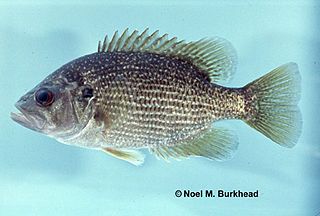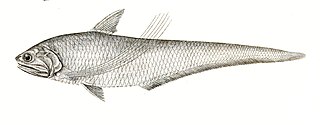
Herring are various species of forage fish, mostly belonging to the family of Clupeidae.

Sardine and pilchard are common names for various species of small, oily forage fish in the herring suborder Clupeoidei. The term 'sardine' was first used in English during the early 15th century; a somewhat dubious etymology says it comes from the Italian island of Sardinia, around which sardines were once supposedly abundant.

The Roanoke bass is a species of freshwater fish in the sunfish family (Centrarchidae) of order Perciformes. This species is endemic to rivers in the eastern United States of America, where it is native only to the states of Virginia and North Carolina.

The American shad is a species of anadromous clupeid fish naturally distributed on the North American coast of the North Atlantic, from Newfoundland to Florida, and as an introduced species on the North Pacific coast. The American shad is not closely related to the other North American shads. Rather, it seems to form a lineage that diverged from a common ancestor of the European taxa before these diversified.

Dorosoma is a genus that contains five species of shads, within the family Dorosomatidae. The five species are native to the North and/or Central America, and are mostly known from fresh water, though some may reside in the waters of estuaries and bays.

The skipjack herring is a North American, migratory, fresh- and brackish water fish species in the herring family Alosidae. The name skipjack shad comes from the fact that it is commonly seen leaping out of the water while feeding. Other common names include blue herring, golden shad, river shad, Tennessee tarpon, and McKinley shad. The skipjack shad is restricted to the Gulf of Mexico drainage basins. Skipjack are found in clear to moderately turbid water in areas with flow. Because they are a migratory species, dams often impede their reproduction. Records suggest that this species was much more abundant in the Upper Mississippi River basin before it was impounded. Currently, skipjack is most abundant in the Upper Mississippi River below the mouth of the Ohio River. They are known as an "early-run" species as they migrate to spawn in the early spring.
The golden pygmy perch is a species of temperate perch endemic to Australia, where it is found in both Ewens Ponds and Deep Creek, South Australia, and several tributaries of the Glenelg River in Victoria. It prefers flowing water of ponds or small streams, generally being more commonly found in the streams that connect to the ponds, with plentiful vegetation or debris to provide shelter. It preys on extremely small crustaceans and aquatic insects. This species can reach 6.5 cm (2.6 in) SL. It can also be found in the aquarium trade.

The allis shad is a widespread Northeast Atlantic species of fish in the Alosidae family. It is an anadromous fish which migrates into fresh water to spawn. It is found in the eastern Atlantic Ocean, the western Baltic Sea and the western Mediterranean Sea. In appearance it resembles an Atlantic herring but has a distinctive dark spot behind the gill cover and sometimes a row of up to six spots behind this. It sometimes hybridises with the twait shad. This fish becomes mature when three or more years old and migrates to estuaries, later swimming up rivers to spawn. Populations of this fish have declined due to overfishing, pollution and habitat destruction. Conservation of this species is covered by Appendix III of the Bern Convention and Appendix II and V of the European Community Habitats Directive.

The twait shad or twaite shad is a species of fish in the family Alosidae. It is found in the eastern Atlantic Ocean and the Mediterranean Sea and is an anadromous fish which lives in the sea but migrates into fresh water to spawn. In appearance it resembles an Atlantic herring but has a row of six to ten distinctive spots on its silvery flanks. They become mature when three or more years old and migrate to estuaries, later swimming up rivers to spawn. Populations of this fish have declined due to overfishing, pollution and habitat destruction. Conservation of this species is covered by Appendix III of the Bern Convention and Appendix II and V of the European Community Habitats Directive.
Alosa vistonica the Thracian shad, is an extinct species of shad, a freshwater fish in the family Alosidae. It was endemic to a single shallow lake, Lake Vistonida in Greece. It was officially declared extinct by the International Union for Conservation of Nature in October 2024 as the species has not been recorded within its only known distribution since 1995.
The variegated mogurnda is a species of fish in the family Eleotridae endemic to Lake Kutubu, Papua New Guinea. This species can reach a standard length of 13 cm (5.1 in).

Gudusia chapra, or the Indian river shad, is a species of fish in the family Clupeidae, occurring in rivers of India and Bangladesh draining to the Bay of Bengal, and also reported from Pakistan and Nepal. Outside the rivers it also occurs in ponds, beels, ditches and inundated fields.

Alosa caspia is a species of alosid fish, one of the species of shad endemic to the Caspian Sea basin.
Alosa volgensis, the Volga shad, is an extinct species of alosid fish. It was endemic to the Caspian Sea region. It was officially listed as extinct by the International Union for Conservation of Nature in 2024.

Gonialosa is a genus of gizzard shads that are found in the rivers of South and Southeast Asia. There are currently three described species.

Gudusia is a genus of freshwater ray-finned fishes belonging to the family Dorosomatidae, the gizzard shads and sardinellas. The fishes in this genus are found in rivers in southern Asia.
Konosirus punctatus is a species of fish in the family Dorosomatidae. It is the only member of the monotypic genus Konosirus. Its common names include dotted gizzard shad and konoshiro gizzard shad. It is native to the northwestern Pacific Ocean, where it occurs along the Asian coastline.

The Alosidae, or the shads, are a family of clupeiform fishes. The family currently comprises four genera worldwide, and about 32 species.
Nematalosa flyensis, the Fly River gizzard or Fly River gizzard shad, is a species of freshwater ray-finned fish within the family Clupeidae. The species is endemic to New Guinea, and is only known to inhabit the Fly River, including its tributary Strickland River.

The Ramcarat grenadier anchovy is a species of marine ray-finned fish belonging to the family Engraulidae, the anchovies. This species is found in the northern Indian Ocean.














